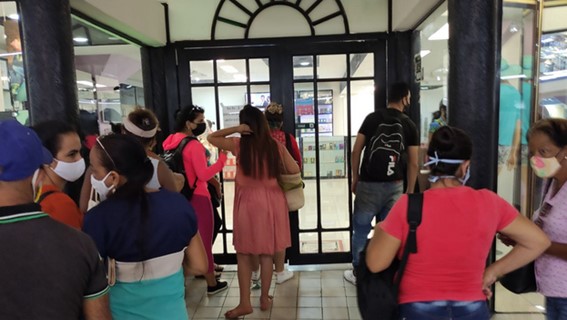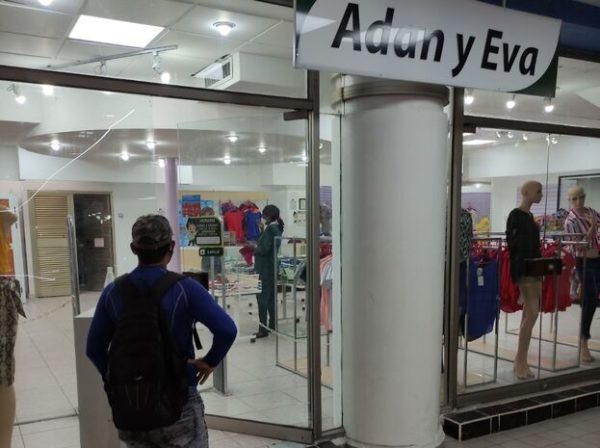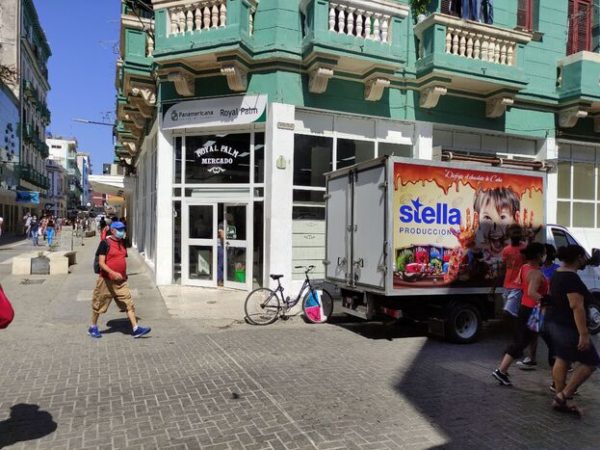Entering a Cuban Dollar Store Can Be Frightening

By Juan Diego Rodríguez (14ymedio)
HAVANA TIMES – From the outside it still looks the same, but inside the Plaza de Carlos III a silent battle is taking place. On the one hand, the best-stocked stores that accept payment only in foreign currency, and on the other, a few stores that still sell in the national currency. For many Cubans, walking through its corridors is an immersion in the economic divide that separates the island.
“I entered the stores [that requirement payment] in MLC (freely convertible currency) in Carlos III, I had never visited them closely,” a Havanan told 14ymedio. After touring the stores that take payment only in foreign currency in this centrally located business in the Cuban capital, this Cuban did not know whether to be happy to find products that are barely seen in the other stores or to be saddened by the “monetary apartheid” that separates citizens.
“What a sadness, I have shopped in those stores for about ten years, but now all, except the food supermarket, [accept payment only] in MLC,” he laments. “Even the children’s flip-flops are being sold in dollars.”
“All the Suchel perfumes and also the imported ones, the shampoos that they sold for a lifetime there in the store for 1 CUC, are now also in dollars,” says this 41-year-old Havanan, born in the 1980s when the Soviet subsidy allowed well-stocked markets and better-stocked display windows. “It was a very strange and sad feeling.”
When he was a child, this Havanan knew the Plaza de Carlos III as a market for food and vegetables. “Dirty, but it also had a fish shop with plenty of offerings and you could buy it with the same currency with which they paid us our salaries.” In the 90s the place was reborn under the dollar and was reopened as the main commercial center of the Cuban capital.
Now, the only shopping complex in the country that bears the name of a king of Spain is entering the realm of covert dollarization that has meant opening stores in MLC where you can only pay with magnetic cards. “This reminds me of the ‘Diego Velázquez houses’,” evokes the frustrated customer.

He was referring to the Gold and Silver Exchange Houses, opened on the island in 1987, where valuable jewels were exchanged for vouchers to buy basic necessities. “My grandmother left everything in that scam: her wedding ring, her hanging crucifix that her mother had left her and even some pieces of gold from her teeth,” explains Mabel, a neighbor of the Plaza de Carlos III who now survives by renting her doorway to a self-employed person who does business there.
“At that time it was clear that they were robbing us,” she adds. Hence the name “Diego Velázquez,” the governor whom popular legend describes as the promoter of deceiving the Cuban natives, exchanging national gold for little mirrors brought from the old continent. “That was an assault and this is a new version of the same robbery,” she says.
“Look at where they sell the jams, all in MLC stores. The delivery truck has in its advertising a child and everything, how cruel!”, comments another resident of Centro Habana when he realized that they were unloading merchandise from a Stella company truck into the Panamericana Royal Palm store, on the Boulevard of Calle San Rafael. Stella is a trading company that belongs to the government’s Ministry of the Food Industry and markets chocolate products.

“My nephews can practically never eat jams. We do not have dollars and when we buy them it is very little, because we do it on the black market and the resellers sell them at exorbitant prices,” adds the Havanan.
In mid-October, the state newspaper Granma published an article stating that the country “will not dollarize its economy” and that the stores in MLC “are necessary but temporary.” In the article, the official organ of the Communist Party quotes Economy Minister Alejandro Gil, who assures that the monetary system “is designed” so that Cuba “works with a single currency: the Cuban peso.”
Raúl Castro himself, in his report to the Eighth Congress of the Communist Party, acknowledged that “the stores in MLC were created to encourage remittances from abroad.” But, at the same time that they collect foreign exchange, they are generating a deep malaise due to the social inequalities they make obvious.






I just got back from Cuba 3 days ago and let me tell you, I literally kissed the ground of my home country Canada because of what I saw and experienced there!! I thought I was going on a week-long vacation in a country I had always wanted to visit; but instead I stepped into a living nightmare where the country’s national currency is refused, where the Canadian dollar, the Euro, and the British Pound are king… —- the Cuban pesos is accepted amongst the shady vendors of the Black Market… ATMs are far and few between and usually EMPTY!! Pharmacies are empty (How is this country known for their excellent medical system?), and food is actually scarce even at the airport where a VIP LOUNGE entry gets you a skimpy ham sandwich and a drink !!! Foreigners should not provide currency to Cubans—— The Cuban government needs to stop this outlandish use of currency and help it’s people from within!!!!
“ . . the official organ of the Communist Party quotes Economy Minister Alejandro Gil, who assures that the monetary system “is designed” so that Cuba “works with a single currency: the Cuban peso.”
How many main street, hard working, Cuban citizens actually believe that? Go out on a Cuban street and ask an ordinary Cuban what they prefer: one American dollar or 25 Cuban pesos? What does the Cuban citizen do with a handful of the national currency when s/he is not allowed entry into an American dollar store? Why does the official Cuban currency – the Cuban peso – bar the majority of Cubans entry to a Cuban store? Pity the poor Cuban mother who needs to purchase much needed footwear for a child or two with only pesos in her purse. The article clearly says: ““Even the children’s flip-flops are being sold in dollars.”” Sad.
Yes, the communist Party has in fact ousted the CUC, the convertible national Cuban money supposedly on equal par with the American dollar. In its place the Cuban economy now operates on two currencies: the American dollar and the Cuban peso. So, yes the majority of Cubans are paid and operate with a single currency: the Cuban peso. But is dividing the nation monetarily into “haves” and “have nots”, though only temporary so they say, any solution to the Cuban economic crisis?
The lucky few Cubans who receive remittances from abroad are fortunate to operate in their own “single currency”: the American dollar. And the Cuban government encourages this by opening a plethora of plentifully stocked stores with goods not available to the single currency: the Cuban peso.
As the article rightly states, and is easily predicable, two economies begin to emerge in the once utopian dream world of complete equity and equality for all citizens in the socialist state. Those with the fortunate resources are able to shop in stores exclusively built and stocked with goods totally unavailable to the majority of hard working citizens.
According to the article this double currency standard “is designed” and the Cuban stores using the American dollar “are necessary but temporary.” It seems whenever a communist regime designs anything for the so called benefit of the masses, “the design” usually turns out to be disastrous in the long run with blame thrown and plastered at anybody and everyone but the perpetrators of the designed disaster.
Also, and it is an historical fact in Cuba, any communist propaganda that proclaims, promotes, and markets any necessary amendment be it in the economy, in this case in peoples’ pockets, or in law, to be “temporary” usually means permanently, or at least until it hurts the perpetrators – the miniscule living in luxury.
The majority of Cubans realize they have to tighten their belts even further – as if the economic belt tightening can get any tighter – because harsher and more penalizing times are ahead with the state’s enactment of monetary manipulation that has no positive bearing on the most vulnerable, like the mother trying to buy flip-flops for family with pesos, and has all the benefits going to the minuscule entitled.
Raúl Castro himself stated that these new American stores were created to import much needed foreign capital, but the end result is according to Juan Rodriguez “ . . they are generating a deep malaise due to the social inequalities they make obvious.” In the long run, social inequality in any society let alone a socialist one does not bode well as history has continuously shown.
The Carlos III shopping mall has always been an upper middle-class buying excursión. Young people, in Havana, in the days before the internet, have often gone there simply to window shop to fuel their imaginations about what life outside of Cuba would be like someday. With the implementation of dollar stores, even the stores that were once almost accessible are now totally out of reach of most Cubans. Cubans will even covet the shopping bags given out by these stores after a major purchase as a measure of their economic status.